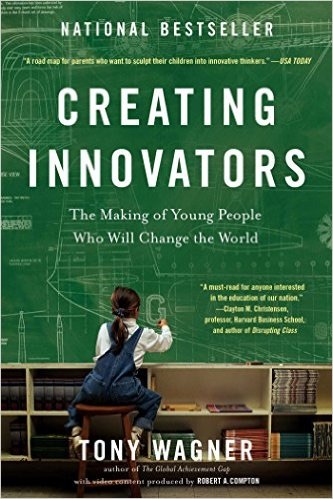
Creating Innovators: The Making of Young People Who Will Change the World by Tony Wagner (© 2012, Scribner: New York, NY) explores what parents, teachers, and employers must do to develop the capacities of young people to become innovators. Tony profiles innovators to identify patterns in their childhood that made them what they are. He shows how to apply his findings to education and tells parents how to compensate for poor schools. Keys include collaboration, interdisciplinary problem-solving, and intrinsic motivation. Sixty original videos are included that you can access via a smartphone. Go to Creating Innovators for a trailer.
A Primer on Innovation
- Innovation is about the process by which new things take place. It involves using novel and creative ways to create value via new products, services, business models, or processes. It involves valuable original ideas or insights that you somehow implement. It’s creative problem solving applied to the real world. Incremental innovation significantly improves products, processes, or services. Disruptive innovations create a new or fundamentally different product or service that disrupts markets and displaces dominant technologies.
- Innovations can be technical like Apple’s iPod, iPhone, and iPad. They can also be social like the nonviolent strategies of Gandhi and M. L. King.
Skills of Innovators/Nature of Creativity
- Tony offers the following as the main skills needed: 1) critical thinking and problem solving 2) collaboration across networks and leading by influence 3) agility and adaptability 4) initiative and entrepreneurship 5) accessing and analyzing information 6) effective oral and written communication 7) curiosity and imagination. It is also necessary to imagine the world from multiple perspectives, see all aspects of a problem, be optimistic, experiment to explore problems with a bias towards action, work with others as the day of the lone genius seems to be over. For places like Google and Apple, intellectual curiosity is more important than smarts. They also want people who will take control of a situation rather than waiting to be lead.
What Is Needed
- Creativity is a habit and like any habit, it can be either encouraged or discouraged. Teachers that value the right answer more than provocative questions tend to drum the curiosity out of students early on. Creativity can be encouraged or discouraged.
- Tony cites work of Teresa Amibile’s who says that creativity or innovation has three components. They are expertise, creative thinking skills, and motivation. She believes that motivation is the most important and that intrinsic motivation has more impact than extrinsic motivation. Tony adds that childhood play should lead to adolescent passion and adult purpose. They are the three interrelated elements of intrinsic motivation. He notes that a disproportionate number of innovative people attended Montessori schools where play is an important part of the curriculum.
What Is Needed
- Knowing how to find those things you are interested in and that motivate you is way more important than specific things you study. This implies that you should put a buffet of opportunities in front of children and let them engage in unstructured play. If a child finds an interest, it should be encouraged.
- Tony tells of a course at Stanford where students work in teams to solve open-ended problems. Most high school and college courses that feature individual competition, specific content, and extrinsic incentives like grades and GPA. What is needed are courses that feature teamwork, multidisciplinary approaches, and the intrinsic incentives of exploration, empowerment, and play.





